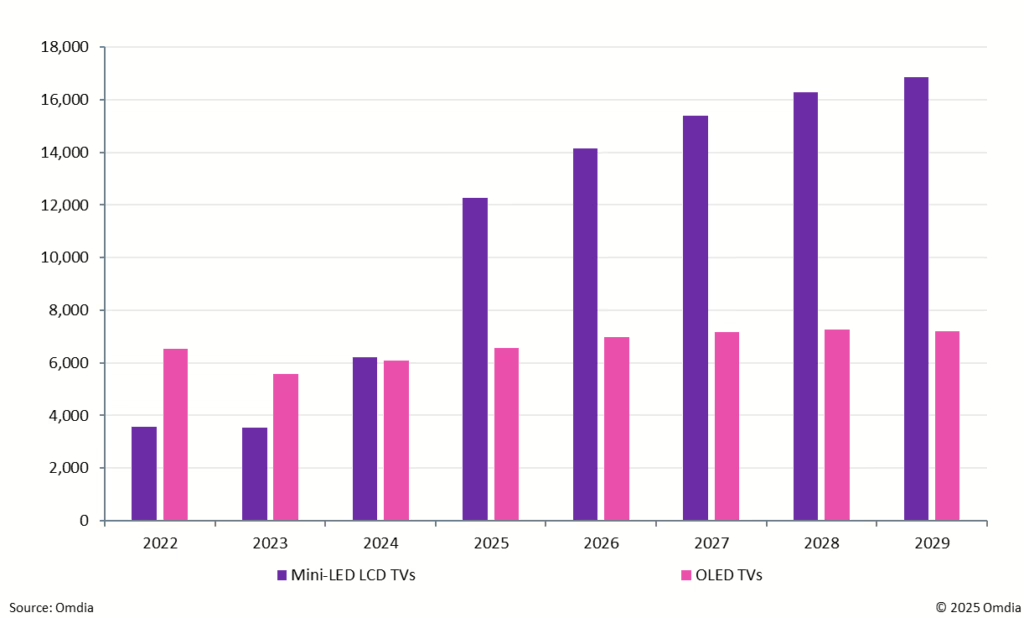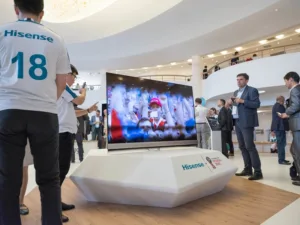Keeping pace with display technology is a pain but I guess it’s part of the job. Each new acronym promises another leap forward, but few deliver the kind of improvements that significantly alter the landscape. However, one trend I genuinely feel excited about is the continuing rise of MiniLED TVs. And it all has to do with my Uncle Jeff, but more on that later.
MiniLED isn’t exactly the new kid on the block. The tech first emerged prominently around 2018, but it was TCL that got the ball rolling for the industry. The TCL 8-Series (2020) marks the commercial debut, while 2021 was the true breakout year.
At its core, MiniLED addresses LCD’s fundamental limitations by packing thousands of miniature LEDs across the TV’s rear panel. Compared to traditional full-array backlights (which typically manage just dozens of zones) MiniLED brings to bear thousands of dimming zones. This dense cluster of tiny LEDs allows manufacturers unprecedented precision in controlling brightness, improving contrast, reducing the halo effect around bright objects, and enhancing HDR performance dramatically. The result is a significant narrowing of the once-wide performance gap between LCD TVs and premium OLEDs.
This is where my Uncle Jeff comes in. He is the only person I know who can comfortably afford premium TV prices, and he reads Consumer Reports, and doesn’t watch any RTings content or stuff like that. Consumer Reports has been bullish on the tech, going as far as to say that MiniLED’s key benefits have steadily migrated beyond the premium segment, becoming increasingly accessible to everyday buyers. Indeed, this tech’s widespread adoption among industry giants, like Hisense, Samsung, TCL, LG, Sony, Sharp, and Panasonic, signals its move firmly into the mainstream. Matt Ferretti, who leads TV testing at Consumer Reports, says MiniLED sets consistently deliver improved black levels, reduced haloing, and vivid HDR imagery, reinforcing their growing reputation as formidable OLED challengers. So, Uncle Jeff has all the ammunition that he needs to go get himself a MiniLED TV, and he’ll want to save money (he didn’t get rich from spending it, let me tell you) so, he might be very happy to not have to buy an OLED premium TV.
Omdia has an interesting take on this broader industry shift, according to Ken Park, Director, TV and ProAV. Hisense made headlines by unveiling a colossal 116-inch RGB MiniLED backlit LCD TV, a product that stole the spotlight at CES 2025. While surpassing TCL’s previous record of 115 inches by just one inch may seem trivial, in marketing terms, it’s pure genius. But what truly turned heads was Hisense’s pricing strategy.
Historically, groundbreaking displays like Samsung’s MicroLED TVs or LG’s rollable OLED screens debut with price tags firmly beyond the reach of typical consumers, often soaring into the six-figure range. LG’s recent transparent OLED offering, for instance, launched in North America at $59,999. Hisense, however, chose a radically different route. Its impressive 116-inch RGB MiniLED TV will cost about $13,777 when it debuts in China this month. While that sounds a little high, Ken Park has given Uncle Jeff a lot of food for thought because TCL’s slightly smaller 115-inch TV currently retails at $19,999.99 in the US, and LG’s 2025 flagship 97-inch OLED is an eye-watering $24,999. Consumer Reports’ two highest ranking MiniLED TVs, from Samsung and Sony, retail at $1497.99 – $1699.99 and $2698.00 – $2999.99 respectively. Hisense and TCL models, that also rank in the top five, retail at an Uncle Jeff friendly $849.99 – $1505.43 and $897.96 – $1399.99 respectively.
According to Omdia, Hisense has turned this traditional approach upside down. RGB MiniLED technology is inherently more expensive than conventional MiniLED, requiring two additional LED chips per cluster (red, green, and blue versus conventional blue or white LED chips) and more complex driver systems. This boosts production costs substantially, making Hisense’s price point even more remarkable and problematic for its competitors. And it seems like all the competitors will be have RGB MiniLED offerings between now and 2026.

According to forecasts from Omdia, a wave of RGB MiniLED TVs from Hisense and Samsung arriving this year, followed by Sony, LG Electronics, and TCL by 2026, will likely set the direction of the premium LCD segment for years to come. The 116-inch model alone won’t change market volume significantly, but Hisense’s strategic entry price, combined with high-end technology, sends an unmistakable signal: premium TVs don’t always have to carry luxury prices.
Buyers like my Uncle Jeff are going to go for bang for buck. Sure, the OLED premium TV market is going to be there for the people who only want the best, but look at what streaming music did to premium audio. There is no premium audio market except for the smallest niches. There probably isn’t going to be a premium TV market in the same way. Remember when Best Buy had Magnolia stores? They are gone now, replaced by Best Buy Premium, which hardly seems like an equivalent branding exercise.
If the LCD TV market transitions to the MiniLED backlight LCD TV market then the only metric that is useful in assessing TV value will be dollars per inch of screen diagonal. And, is it RGB MiniLED or what, dude? Uncle Jeff is not going to like that conversation.

